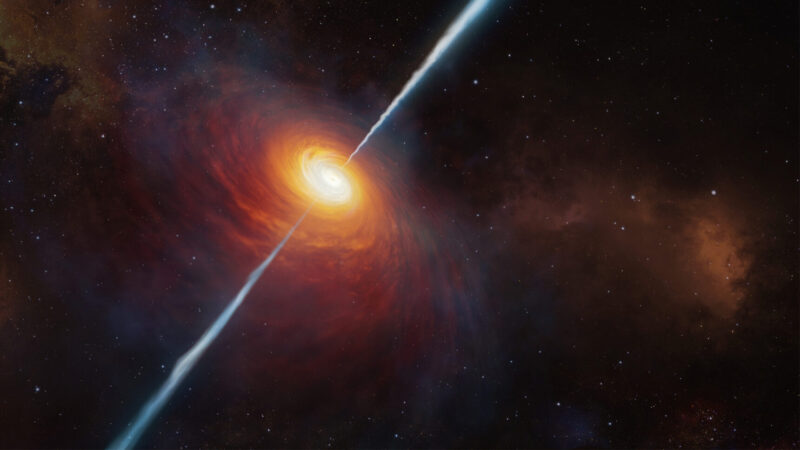Black holes, those enigmatic cosmic phenomena, have fascinated astronomers and physicists alike for decades. Hidden within the depths of their gravitational prowess lies a remarkable and intricate process: the formation of jets. These astonishing streams of charged particles, propelled at nearly the speed of light, shoot out into the cosmos, defying our conventional understanding of space and matter. To the untrained eye, the idea of a black hole—a region from which nothing can escape—seems paradoxical to the violent ejections of material that we observe.
Yet, it is precisely this tension between gravity’s inexorable pull and the violent dynamics at play that gives rise to these jets. In this exploration, we will delve into the mechanisms behind black hole jet formation, illuminating the complex interplay of magnetic fields, accretion discs, and relativistic effects that govern this captivating cosmic ballet. Each discovery in this arena not only enhances our understanding of black holes but also pushes the boundaries of modern astrophysics.
Introduction to Black Holes
Black holes, those enigmatic cosmic phenomena, capture the imagination and challenge the understanding of modern astrophysics. Formed from the remnants of massive stars that have exhausted their nuclear fuel, these regions of spacetime exhibit gravitational pulls so intense that nothing, not even light, can escape their grip.
Yet, amidst this dark annihilation, a paradox arises: the formation of dazzling jets that shoot out from their vicinity, illuminating the darkness and hinting at the complex physics at play. These jets, which can extend across vast distances, are not mere byproducts of black holes but are integral to their nature, revealing a dynamic interplay between gravity, magnetic fields, and high-energy particles.
As we delve into the scientific explanations behind black hole jet formation, we will uncover the intricate mechanisms that allow these monstrous entities to launch energetic streams into the cosmos, forever altering our perception of the universe.
The Structure of Accretion Disks
The structure of accretion disks surrounding black holes is a fascinating interplay of matter, gravity, and angular momentum. Composed primarily of gas and dust spiraling inward, these disks showcase a range of dynamic behaviors, from the soothing smoothness of slowly rotating layers to the chaotic turbulence that can erupt under extreme conditions.
At the innermost edge, where the gravitational pull is strongest, material heats up significantly, emitting X-rays that reveal the disk’s furious energy. As particles within the disk collide and interact, they not only lose angular momentum, allowing some material to fall into the black hole, but also create conditions ripe for magnetic field generation.
These magnetic fields can channel outflows and jets, launching particles at astonishing speeds far beyond the confines of the disk. Thus, the accretion disk serves as both a vibrant theater of astrophysical processes and a crucial engine driving the enigmatic jets observed in many black hole systems.
Conditions for Jet Formation
The formation of jets emanating from black holes hinges on a delicate interplay of factors. First and foremost, the intense gravitational pull of a black hole can strip material from a companion star or surrounding accretion disk, creating a swirling mass of superheated plasma.
As this material spirals inwards, it’s compelled by magnetic fields that distort and stretch along the rotation axis of the black hole. This isn’t a straightforward process; turbulence within the accretion disk and varying magnetic configurations can lead to unstable conditions, shaping the jet’s structure and direction. Ultimately, when these dynamic forces align, they facilitate the pollination of particles, allowing them to escape at nearly the speed of light, forming the spectacular and often dazzling jets observed in the universe.
All of this occurs against a backdrop of extreme physical conditions, where gravity, electromagnetic forces, and relativistic effects converge in a cosmic dance, illuminating the remarkable phenomena associated with black holes.
Conclusion
In conclusion, the formation of black hole jets is a captivating phenomenon that underscores the interplay between extreme gravitational forces and the behavior of matter in the vicinity of black holes. How do black hole jets form? As matter spirals into a black hole, the intense gravitational and magnetic fields at play can accelerate charged particles, resulting in the collimation of ultra-relativistic jets.
These jets form as a result of the intricate dynamics of accretion disks, coupled with the magnetic field lines that are twisted and stretched by the rotational energy of the black hole. Understanding the mechanisms behind black hole jet formation not only deepens our insight into the nature of these enigmatic cosmic entities but also enriches our broader comprehension of astrophysical processes across the universe. The ongoing research in this field promises to unravel even more mysteries surrounding black holes, offering us a front-row seat to the extraordinary events that unfold in the depths of space.


